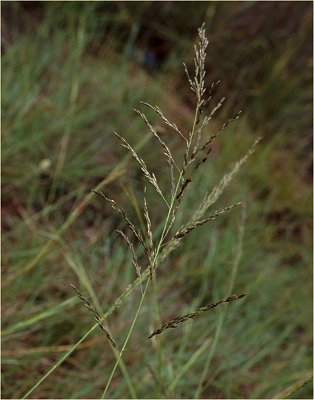Eragrostis curvula* (Schrad.) Nees. Fl.
Afr. Austr. 397 (1841).
Classification. (GPWG 2001) : Subfamily
Chloridoideae. Cynodonteae.
Basionym and/or
Replacement Name: Poa curvula Schrad.,
Gott. Gel. Anz. 3: 2073 (1821).
Type of Basionym or
Protologue Information: HT: Hesse s.n., South
Africa: Cape Province: Cape of Good Hope (LE (ex GOET)?; IT: GOET-2265,
LE-TRIN-2327.01 (lower middle specimen)). ["Poa curvula Schrad. Anal. de
Fl. Cap., det cl. Schrader, Gött. 1836. C. b. sp., m Hesse".
Veldkamp, Blumea 47: 173 (2002) cites "Type: Hesse
s.n. in Herb. Trinius 2327.1 (2327.3?) (holo PH?; LE, iso, microfiche
IDC BT-16/1)." PH is doubtfully the depository of the HT as this refers to
grass material exchanged with Muhlenberg, and Hitchcock and Chase certainly
would have uncovered that. Most likely the HT is at LE and an IT in the Trinius
herbarium there.] [rjs 2004] ].
Key references
(books and floras): [1952] C.A.Gardner, Flora of Western Australia 1
Gramineae (118), [1969] E.E.Henty, Manual Grasses New Guinea
(96), [1981] M.Lazarides in J.Jessop (ed)., Flora of Central Australia
(460), [2002] D.Sharp & B.K.Simon, AusGrass, Grasses of Australia,
[2002] J.Wheeler, N.Marchant & M.Lewington, Flora of the South West (417),
[2006] J.Jessop, G.R.M.Dashorst, F.M.James, Grasses of South Australia
(367), [2008] S.W.L.Jacobs, R.D.B.Walley & D.J.B.Wheeler, Grasses of New
South Wales (250).
Illustrations:
[1952] C.A.Gardner, Flora of Western
Australia 1 Gramineae (117, Pl. 33),
[2006] J.Jessop, G.R.M.Dashorst, F.M.James, Grasses of South Australia (368, Fig. 296), [2008] S.W.L.Jacobs,
R.D.B.Whalley & D.J.B.Wheeler, Grasses of New South Wales, 4th edn
(250).
Habit.
Perennial. Culms erect or decumbent, 30–120 cm tall. Ligule a fringe of hairs,
0.3–1 mm long. Leaf-blades straight or curled, filiform or linear, flat or
convolute, 10–30 cm long, 1–3 mm wide.
Inflorescence.
Inflorescence compound, a panicle. Panicle lanceolate or ovate, 6–30 cm long.
Spikelets.
Spikelets pedicelled. Fertile spikelets many flowered, with at least 2 fertile
florets (4–13), comprising 4–13 fertile floret(s), with diminished florets at
the apex, linear, laterally compressed, 4–10 mm long.
Glumes. Glumes
similar. Lower glume lanceolate, keeled, 1-keeled, 1 -nerved. Upper glume ovate,
1.5–3 mm long, keeled, 1-keeled, 1 -nerved.
Florets.
Fertile lemma 1.8–2.8 mm long, without keel or keeled, 3 -nerved. Lemma apex
muticous. Anthers 3. Grain 0.7 mm long.
Continental
Distribution: Africa, Temperate Asia, Tropical Asia, Australasia, Pacific,
North America, and South America.
Australian
Distribution: Western Australia, Northern Territory, South Australia,
Queensland, New South Wales, Victoria, Tasmania.
Western Australia: Drummond, Eyre. Northern Territory: Central
Australia South. South Australia:
Nullabor, Eyre Peninsula, Murray,
Southern Lofty, South-eastern. Queensland:
Burnett, Darling Downs, Leichhardt, Moreton, North Kennedy, Port Curtis, Wide Bay,
Maranoa. New South Wales: Central Coast,
South Coast, Northern Tablelands, Central
Tablelands, Southern Tablelands, North-Western Slopes, Central-Western Slopes,
South-Western Plains. Victoria:
Gippsland Plain, Midlands, Murray
Mallee, Riverina, Volcanic Plain, Wimmera. Tasmania: South West.
Notes.
Introduced as a fodder plant, and soil binder. A cultivar, "Consol",
has been registered because of its useful features, that is drought tolerance,
persistence, frost hardiness, herbage production and soil control in drier
areas with infertile sands and similar light soils.
Distinguishing characters include sericeous
cataphylls and basal sheaths; filiform-capillary blades; scaberulous, weakly
flexuose rachilla; dividing palea; unequal glumes.
.
Introduced;
scattered occurrence in W.A. from Carnarvon to Esperance and then more
widespread in SE Australia. Also recorded from
S of Alice Springs in N.T.; native to Africa, introduced into Papua New Guinea and Australia. Disturbed sites
(roadsides, experimental plots, habitation); sandy, solodic, alluvial sometimes
saline soils, river banks; behind beach dunes.; flowers all year round but not
recorded for Sept.; fruits all year round but not recorded for Sept.






